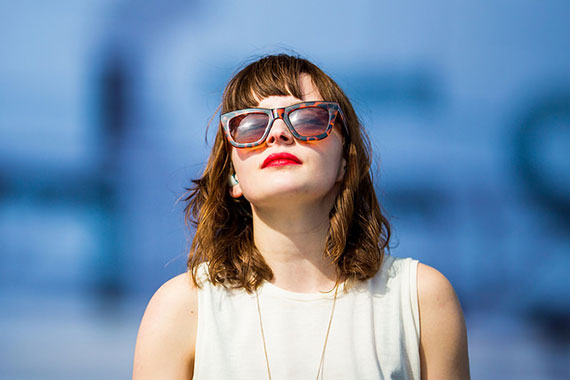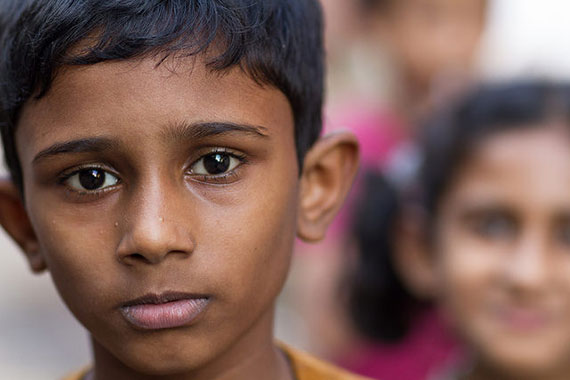You can create a blurry background in your portrait photography with a very simple process.
When you are photographing people, a soft focus background can help rid your photo of any potential distractions. This effect is called a shallow depth of field.

Photo by Thomas Hawk; ISO 200, f/2.0, 1/8000-second exposure.
With a shallow depth of field, just the face or person is in focus, and the background is progressively blurry. In a longer depth of field, your subject and everything in the background is sharply in focus.
Here are the four ingredients to consider when creating a dramatically shallow depth of field:
1. Wide Aperture
One of the first lessons in manipulating exposure is that the size of your aperture controls your depth of field. The larger the opening for each shot, the smaller the amount of your photo will be in focus. Choose lower numbers, like f/2 to f/4, to get the most dramatic effect. Remember that aperture f-stop numbers work in reverse; the lower numbers represent the larger openings.
2. Distance to Your Subject
Getting close to your subject is a great composition principle anyway, but it is even more important when you want to knock out your background. If you are 10 feet from your subject, it is much easier to create a shallow depth of field than if you are 50 feet from your subject.
3. Amount of Zoom
When you zoom in, you compress the elements of your photo, so everything behind your subject becomes more dramatic. A wide angle lens might not create a shallow depth of field, but if you zoom in a telephoto lens to 100 mm to 200 mm, the results become far more dramatic.
4. Size of Your Sensor
Your sensor size will impact the final quality of your image in many ways. Making your background blurry is just one of them.

Photo by Adam Cohn; ISO 640, f/2.2, 1/640-second exposure.
Don’t try to get a shallow depth of field with a camera phone. The sensor is so tiny, you won’t see much effect. With a compact camera (point and shoot), it is possible to manipulate depth of field, but difficult. With a DSLR, you can start to see really dramatic effects because the sensor is much larger.
Blurring out your background is one of many composition techniques you can use to create great portrait photography. With four easy ingredients, you could be on your way to making outstanding pictures.
About the Author:
Lynford Morton (www.shutterbuglife.com) spends weekends at Washington, DC’s favorite locations—making new friends and sharing his love of photography with eager new photographers.
Like This Article?
Don't Miss The Next One!
Join over 100,000 photographers of all experience levels who receive our free photography tips and articles to stay current:




Hi.i just bought a nikon d5200 but Knows Nothing about Dslr but nées to take a depth Of filer for saturât CAN anyone Helpl.
@Pratap Misra, you will have a hard time creating a shallow DoF with a stock lens. Im not a Nikon person, but with Canon, they have an Aperature priority setting where it will adjust the shutter speed based on your aperature setting. You would make it as low of a number as possible (likely 3.5 is as low as that type of lens will go) remember smaller the number (1.2, 1.8, 3.5, 5.6…etc) the more ‘open’ the aperature is, and the ‘faster’ the lens must be. The more open the aperature, the shallower the DoF is. Your best bet with that type of lens is to stand back, zoom in (zooming helps to create more shallow DoF) close to your subject, and have whatever is in the background to be as far away as possible. This will create your bokeh. I do lots of portraits, so I definitely understand the importance of bokeh on a photo.
Feel free to ask me questions any time or like me on Facebook if you wanna keep in touch!
You might want to edit your “Wide aperture” paragraph and change the references of “the size of your shutter controls your depth of field” and “The larger the shutter opening. . ” when I think you really mean aperture. You might confuse new photographers who don’t know the difference between aperture and shutter speed.
How is possible to get shallow DOF with good DSLR with standard kit lens? 18-55 in case of Nikon or Sony. When you drag the zoom towards 55mm(max 75mm in case of 35mm keeping crop factor to 1.5X) the aperture will increase to 5.6 automatically and result is not too good. The only solution is micro lens of 50mm or 75mm or higher with fixed aperture. They are designed to create the shallow DOF
That Bliss photo’s awesome. Very good post as well :)
I have a similar, but more technical (more boring maybe) that nicely supplements this great write-up by Lynford. – http://reviews.davidleetong.com/popping-portraits-how-and-why-2/
Dave